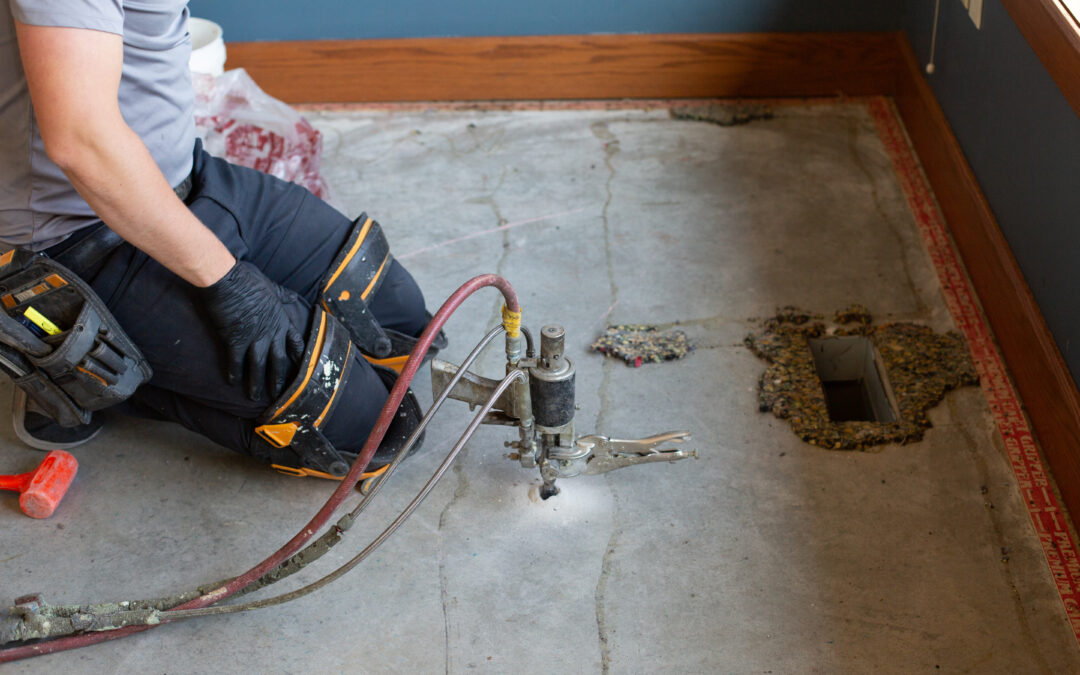Concrete slab jacking (also known simply as concrete lifting or concrete leveling) has long been used to correct issues related to concrete settlement—sinking sidewalks, uneven driveways, patios, etc. Traditionally, mudjacking (or cementitious slurry methods) was the go-to method. But in recent years foam jacking—using high-density polyurethane foam—has begun to reshape the industry. Here’s how and why.
What Is Foam Jacking (Polyurethane Foam Slab Jacking)?
Foam jacking (also called polyjacking, or polyurethane foam concrete lifting) is a technique in which a two-part polyurethane resin is injected beneath a settled concrete slab. Once injected, the resin expands into foam, filling voids under the slab, compacting or stabilizing soil, and raising the slab back to a level position.
Unlike mudjacking, which uses a heavy fluid slurry (cement, sand, water) pumped beneath the slab, foam jacking uses a much lighter material, smaller holes, and typically cures or sets up far more quickly.
What’s Driving the Shift Toward Foam Jacking
Here are some of the reasons foam jacking is increasingly preferred over older methods in many scenarios:
-
Faster Cure Time & Less Downtime
Polyurethane foam often cures rapidly—sometimes within minutes—and allows restored concrete to be used again almost immediately. This contrasts to mudjacking or full replacement, which may require waiting for slurry to settle, cure, dry, etc. -
Smaller Holes / Less Invasive
Injection holes for foam jacking are quite small (often about the size of a dime or ~⅝”) compared to the larger holes used in mudjacking. This means less visible repair work, and less damage / aesthetic disturbance to surfaces. -
Lightweight Material / Less Added Load
Because the foam is lightweight, there’s much less added weight pressing down on potentially compromised soil. This helps reduce further soil compression or settlement, which could otherwise happen if heavy materials are used. -
Improved Soil Stabilization & Filling Voids
Foam doesn’t just lift—it fills voids under slabs and can compact weak soils, helping to stabilize the foundation beneath the slab. This reduces the likelihood of future settlement, especially in areas where soil has eroded or washed out. -
Durability & Longevity
Polyurethane foam is generally more resistant to moisture, erosion, freeze-thaw cycles, and environmental wear. Because of that, foam jacking often provides longer-lasting solutions compared to older methods. It’s less prone to washout, degradation, or losing effectiveness over time. -
Cost Efficiency in the Long Run
Although foam jacking may have a higher initial material cost than mudjacking, its speed, reduced labor, less mess, and lower maintenance/repeat repair needs often make it more cost-effective over the life of the repaired slab. -
Versatility of Applications
Foam jacking works well in many contexts: driveways, sidewalks, patios, garage floors, pool decks, foundations, industrial slabs, etc. It’s especially useful in tight or delicate areas where large machinery or messy slurry would be problematic.
Challenges and Considerations
While foam jacking has many benefits, it’s not without its challenges. Here are a few to be aware of:
-
Cost: Material costs for polyurethane foams are higher. The trade-off is often in reduced labor and repeat repairs.
-
Training / Skill Required: Because of the expanding nature of foam, technicians must be well trained to avoid over-lifting, uneven fill, or creating new stresses in the slab.
-
Void Geometry: Very large voids or extremely poor soils might still need additional soil stabilization or other engineering measures beyond just foam injection. Foam works very well for many situations, but it’s not always a solution.
How Foam Jacking Is Changing the Industry
Putting together the above points, here are some ways foam jacking is transforming how the slabjacking / concrete lifting business operates:
-
Faster Service & Happier Customers: Because cures are fast and disruption is minimal, homeowners or businesses get back to normal more quickly. This improves satisfaction and often increases demand.
-
New Business Opportunities: Contractors specializing in spray foam insulation or coatings can more readily offer concrete lifting services with relatively modest additional investment. This opens up more revenue streams.
-
Shift in Standards / Expectations: As foam jacking becomes more common, customers increasingly expect shorter project times, cleaner work, and longer warranties. Companies offering mudjacking or older methods are under pressure to match these standards or lose business.
-
Environmental / Regulatory Impacts: Less disruption, less waste (less removed concrete, less heavy machinery), and less mess generally mean companies using foam jacking may have fewer regulatory obstacles or cleanup issues. Also, by lifting instead of replacing concrete, less material ends up in landfills.
Conclusion
Foam jacking—using polyurethane foam—is not just an evolution in concrete slab jacking: in many ways it’s a revolution. Its ability to lift concrete quickly, with minimal disruption, with longer-lasting results, is pushing the industry forward. That said, mudjacking and other methods still have roles in some situations. For most homeowners concerned with aesthetics, downtime, and long-term value, foam jacking is becoming the standard.
If you own or manage property and are dealing with sunken or settling concrete, it’s worth consulting with experts in foam jacking (polyurethane concrete lifting) to see if it’s the right fit for your specific situation.
Contact Sealtite Insulation & Slabjacking Today!
📞 855-692-3626
🌐 www.sealtiteinsulation.com
